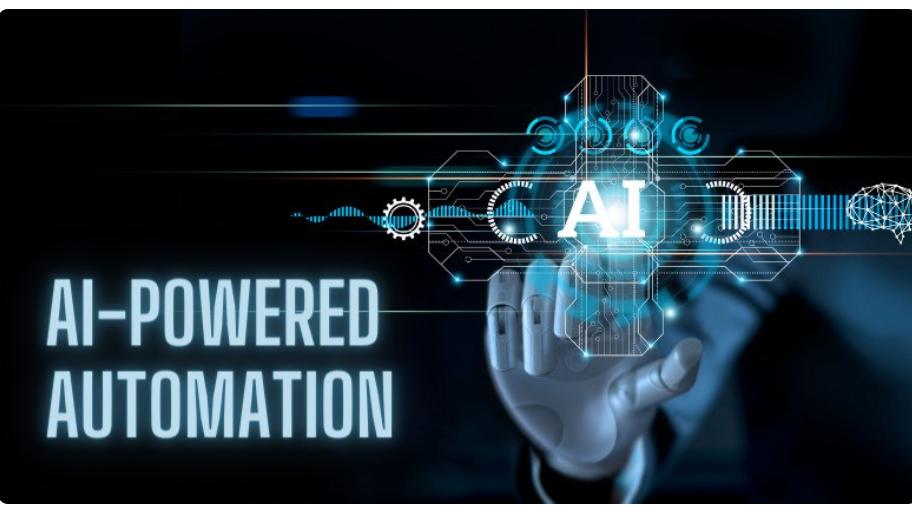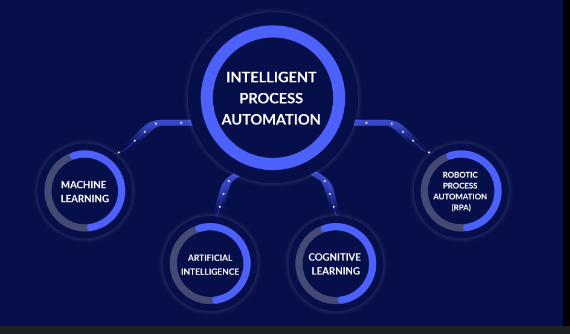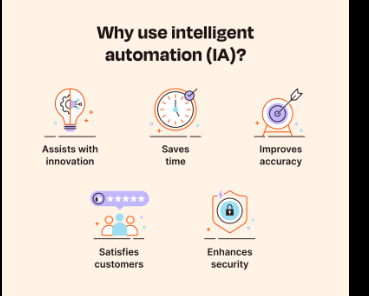
<a href="http://<!– wp:paragraph –> <p>AI and Automation – Revolutionizing Industries for Enhanced Productivity and Efficiency 2024</p> AI and Automation – Revolutionizing Industries for Enhanced Productivity and Efficiency 2024
Introduction Artificial Intelligence (AI) and automation have redefined the way businesses operate. From streamlining simple tasks to automating complex processes, AI is at the forefront of driving productivity and efficiency. In this blog, we delve into process automation using AI, AI-driven Robotic Process Automation (RPA), and intelligent task automation, along with their impacts across industries.
1. Process Automation Using AI

Process automation involves the use of AI to handle repetitive and rule-based tasks, allowing employees to focus on more strategic work. AI-driven process automation uses algorithms to process data, make decisions, and adapt to changing scenarios.
Key Features and Benefits:
- Reduced Human Error: AI algorithms are less prone to errors compared to manual tasks, ensuring high accuracy and consistency.
- Enhanced Speed: Tasks that take hours or days can be completed in minutes, leading to faster service delivery.
- Cost Savings: Automating processes reduces the need for extensive manual labor, leading to significant cost reductions over time.
Use Cases of Process Automation:
- Document Management: Automating the scanning, classification, and extraction of data from documents.
- Data Entry: Automating the input of data into systems, reducing manual labor and errors.
- Workflow Automation: Managing approval processes and notifications in project management tools.
Example Code for Data Processing:
<!-- Sample HTML code for visualizing data processing -->
<div>
<h3>Data Processing Output</h3>
<pre>
<code>
// Pseudo-code for data processing using AI
inputData = load_data('dataset.csv')
processedData = process_data(inputData)
display_data(processedData)
</code>
</pre>
</div>
2. AI-Driven Robotic Process Automation (RPA)

RPA refers to software robots that emulate human interactions with digital systems to perform repetitive tasks. When combined with AI, RPA becomes more intelligent, enabling it to handle unstructured data and make context-aware decisions.
Key Features of AI-Driven RPA:
- Scalability: AI-enhanced RPA can be scaled up or down based on business requirements.
- Cognitive Capabilities: AI-driven RPA can understand speech and written language, interpret unstructured data, and make decisions based on contextual understanding.
- Integration with Legacy Systems: RPA can work across older software systems without the need for major changes to the existing infrastructure.
Example Applications:
- Customer Onboarding: Automating form submissions, identity verification, and profile creation.
- Invoice Processing: Extracting details from invoices and inputting them into ERP systems.
- Claims Processing: Automating the evaluation and validation of insurance claims, reducing processing time.
Code Example for Task Automation Logic:
<div>
<h3>AI-RPA Task Automation Logic</h3>
<pre>
<code>
// Pseudo-code for RPA using AI
taskList = ['read email', 'extract invoice', 'update database']
for task in taskList:
if AI_model.detect_task(task):
AI_model.perform_task(task)
</code>
</pre>
</div>
The benefits of RPA
There are multiple benefits of RPA, including:
- Less coding: RPA does not necessarily require a developer to configure; drag-and-drop features in user interfaces make it easier to onboard non-technical staff.
- Rapid cost savings: Since RPA reduces the workload of teams, staff can be reallocated towards other priority work that does require human input, leading to increases in productivity and ROI.
- Higher customer satisfaction: Since bots and chatbots can work around the clock, they can reduce wait times for customers, leading to higher rates of customer satisfaction.
- Improved employee morale: By lifting repetitive, high-volume workload off your team, RPA allows people to focus on more thoughtful and strategic decision-making. This shift in work has a positive effect on employee happiness.
- Better accuracy and compliance: Since you can program RPA robots to follow specific workflows and rules, you can reduce human error, particularly around work which requires accuracy and compliance, like regulatory standards. RPA can also provide an audit trail, making it easy to monitor progress and resolve issues more quickly.
- Existing systems remain in place: Robotic process automation software does not cause any disruption to underlying systems because bots work on the presentation layer of existing applications. So, you can implement bots in situations where you don’t have an application programming interface (API) or the resources to develop deep integrations.
3. Intelligent Task Automation

Intelligent task automation involves automating tasks that require a level of human intelligence. It combines the capabilities of AI, machine learning, and cognitive computing to perform tasks such as customer service interactions, predictive maintenance, and inventory management.
Features of Intelligent Task Automation:
- Learning and Adaptation: These systems use machine learning to adapt and improve performance over time.
- Context-Awareness: Intelligent automation systems are capable of understanding the context of tasks, making decisions based on situational awareness.
- Complex Problem Solving: Automation can be applied to solve complex problems, including financial analysis, supply chain logistics, and IT operations management.
Applications Across Industries:
- Customer Support: AI-powered chatbots respond to customer queries 24/7, improving response time and overall customer satisfaction.
- Predictive Maintenance in Manufacturing: Sensors gather real-time data, and AI models predict equipment failure before it happens, preventing costly downtime.
- Healthcare Automation: AI assists with patient data analysis, helping doctors create personalized treatment plans and prioritize patient care.
- Retail Management: Intelligent automation optimizes inventory, forecasts demand, and automates restocking processes.
HTML Code for Displaying Predictive Maintenance Logic:
<div>
<h3>Predictive Maintenance Logic</h3>
<pre>
<code>
// Pseudo-code for predictive maintenance
sensorsData = gather_sensor_data()
maintenanceModel = train_model(sensorsData)
if maintenanceModel.predict_failure():
alert('Schedule maintenance')
</code>
</pre>
</div>
Impact of AI and Automation on Industries
The integration of AI and automation across industries has far-reaching impacts:
- Manufacturing: Automated production lines powered by AI reduce errors, enhance quality control, and optimize production schedules.
- Healthcare: Automation tools assist in diagnostics, patient data management, and administrative tasks, allowing medical professionals to focus more on patient care.
- Finance: Fraud detection algorithms scan vast amounts of transaction data to identify suspicious activities in real-time. AI-driven advisory tools provide personalized financial guidance to users.
- Logistics and Supply Chain: Automation enhances route optimization, shipment tracking, and inventory management, leading to lower operational costs and higher efficiency.
- Retail and E-commerce: Automates customer engagement with AI chatbots, personalized recommendations, and stock management systems.
- Human Resources: AI tools streamline the recruitment process, automate candidate screening, and assist in employee onboarding.
Challenges and Considerations:
- Data Privacy: Automating processes involving sensitive information must comply with data protection laws.
- Skill Gaps: As automation grows, upskilling workers to manage and work alongside these new technologies is crucial.
- Ethical AI: Ensuring fairness and avoiding bias in AI algorithms remains a key challenge that companies must address.
Conclusion AI and automation are transforming industries by enabling smarter, more efficient processes. From simple rule-based automations to advanced RPA and intelligent task handling, businesses are now better equipped to enhance productivity, reduce operational costs, and scale efficiently.
As technology advances, the potential for AI-driven automation will only grow, making it an essential component for future-ready enterprises.